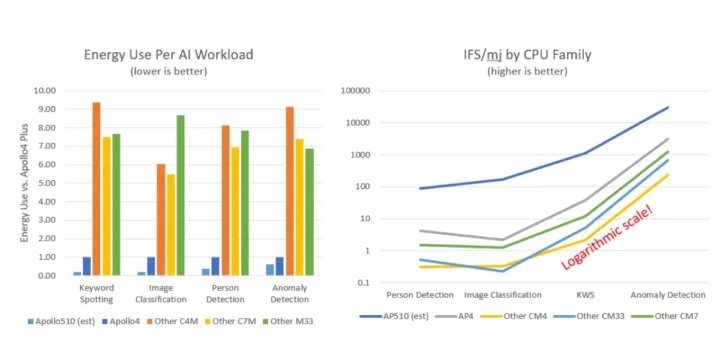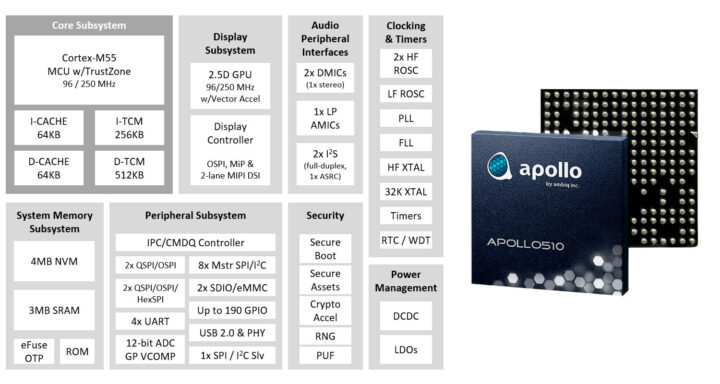Ambiq Apollo510 Arm Cortex-M55 microcontroller delivers 30 times better power efficiency than typical Cortex-M4 designs and 10 times the performance of the Apollo4 Cortex-M4 sub-threshold microcontroller for AI and ML workloads.
The new MCU also comes with 4MB NVM, 3.75MB SRAM, a 2.5D GPU with vector graphics acceleration that’s 3.5 times faster than the Apollo4 Plus, and support for low-power Memory-in-Pixel (MiP) displays. Like all other Ambiq microcontrollers, the Apollo510 operates at sub-threshold voltage for ultra-low power consumption and implements security with the company’s secureSPOT platform with Arm TrustZone technology.
Ambiq Apollo510 specifications:
- MCU Core – Arm Cortex-M55 core up to 250 MHz with Arm Helium MVE, Arm TrustZone, FPU, MPU, 64KB I-cache, 64KB D-cache, 256KB I-TCM (Tighly Coupled Memory), 256KB D-TCM,
- Graphics – 2.5D GPU clocked at 96 MHz or 250 MHz with vector graphics acceleration, anti-aliasing hardware acceleration, rasterizer/full alpha blending/texture mapping, texture/framebuffer compression (TSC4, 6, 6A and 12), dithering and radial/conical fill support
- Ultra-low power memory and storage
- Up to 4MB of non-volatile memory for code/data
- Up to 3.75MB of TCM and system RAM for code/data
- Display
- Memory in Pixel (MiP) display interface with fast-forward
- LCD controller
- MIPI DSI 1.2 with 2 data lanes up to 1.5 Gbps (768 Mbps per lane)
- Up to 640×480 resolution at 60 fps
- 4 layers with alpha blending
- Frame buffer decompression
- Audio
- 1x LP always-on Audio ADC
- 2x PDM DMIC interface
- 2x full-duplex multichannel I2S ports, 1x with ASRC (asynchronous sample rate converter)
- Peripheral interfaces
- 2x 1/2/4/8-bit wide SPI master interfaces
- 2x 1/2/4/8/16-bit wide SPI master interface
- 8x I2C/SPI masters for peripheral communication
- I2C/SPI slave for host communications
- 4x UART modules with FIFOs and flow control
- 1x USB 2.0 FS/HS device controller
- 2x SDIO v3.0/eMMC controllers
- Up to 183x GPIO
- Analog
- 12-bit ADC, 11 selectable input channels with up to 1.7 MS/s sampling rate
- Temperature sensor with ±3°C accuracy
- Clock sources
- PLL for precise clocking applications
- 16-52 MHz and 32.768 kHz Crystal (XTAL) oscillators
- 1 kHz Low Frequency RC (LFRC) oscillator
- 2x High Frequency RC (HFRC) oscillator
- Security Features
- Arm TrustZone
- Secure boot
- OTP key storage
- PUF-based identity/sign/verify
- Secure over-the-air (OTA) updates
- Secure wired updates
- Key revocation
- Power Management
- Operating range – 1.71-2.2 V
- SIMO buck
- Multiple I/O voltages supported
- Packages
- BGA with 183x GPIO
- CSP with 144x GPIO
- Temperature Range – -20°C to +70°C (commercial) or -40°C to +85°C (industrial)

The Apollo510 microcontroller benefits from the Cortex-M55 core optimized for artificial intelligence workloads that Arm claims to deliver up to a 15x uplift in ML performance. Combined with other features, it gives it the ability to do AI/ML workloads concurrent with complex graphics, telco-quality voice applications, and always-on voice/sensor processing suitable for wearables, IoT sensors, fitness monitors, alarm and security systems, medical devices, predictive maintenance solutions, and a range of Smart Home devices.
The chart above shows the Ambiq microcontrollers, such as Apollo510 and Apollo4, deliver much better energy use per AI workload than other Arm microcontrollers based on Cortex-M4, Cortex-M7, and Cortex-M33 cores when running tasks such as keyword spotting, image classification, person detection, and anomaly detection. Ambiq further explains the Apollo510 achieves 16x better latency while reducing power by over 2x compared to Ambiq’s Apollo4.
The company has not provided much detail about developer resources, although I can see the AP510EVB evaluation board for the Apollo510 is mentioned in the product brief without other details. Ambiq says the Apollo510 MCU is currently sampling to customers and general availability is expected in Q4 2024. The company will also showcase the new microcontroller at Embedded World 2024 on April 9- 11. Additional information may be found on the product page and in the press release.

Jean-Luc started CNX Software in 2010 as a part-time endeavor, before quitting his job as a software engineering manager, and starting to write daily news, and reviews full time later in 2011.
Support CNX Software! Donate via cryptocurrencies, become a Patron on Patreon, or purchase goods on Amazon or Aliexpress





